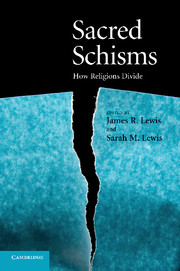Book contents
- Frontmatter
- Contents
- List of figures
- Notes on contributors
- Acknowledgments
- Introduction
- PART I THEORETICAL OVERVIEW
- PART II SURVEY OF SCHISMS IN SELECTED TRADITIONS
- PART III CHRISTIAN TRADITIONS
- PART IV WESTERN ESOTERIC TRADITIONS
- PART V NON-WESTERN/POSTCOLONIAL TRADITIONS
- 12 Succession, religious switching, and schism in the Hare Krishna movement
- 13 Schisms within Hindu guru groups: the Transcendental Meditation movement in North America
- 14 Schism in Babylon: colonialism, Afro-Christianity and Rastafari
- Index
- References
14 - Schism in Babylon: colonialism, Afro-Christianity and Rastafari
Published online by Cambridge University Press: 24 October 2009
- Frontmatter
- Contents
- List of figures
- Notes on contributors
- Acknowledgments
- Introduction
- PART I THEORETICAL OVERVIEW
- PART II SURVEY OF SCHISMS IN SELECTED TRADITIONS
- PART III CHRISTIAN TRADITIONS
- PART IV WESTERN ESOTERIC TRADITIONS
- PART V NON-WESTERN/POSTCOLONIAL TRADITIONS
- 12 Succession, religious switching, and schism in the Hare Krishna movement
- 13 Schisms within Hindu guru groups: the Transcendental Meditation movement in North America
- 14 Schism in Babylon: colonialism, Afro-Christianity and Rastafari
- Index
- References
Summary
Jamaica, the third largest island in the West Indies, has more than 2.5 million inhabitants and is commonly known not only as a popular tourist destination, but also for its religion and popular culture – most notably reggae and Rastafarianism. The latter, however, is very much a product of another fact of particular significance that is central to the argument of this chapter. Throughout Jamaica there are place names and large plantation mansions that serve to remind the people that their land was, until 1962, a British colony and, until August 1, 1838, a slave colony. The aim of this chapter is simply to argue that these latter exogenous factors are central to understanding schism in African-Caribbean religion. In other words, schism in Jamaican religion is fundamentally related to the colonial and postcolonial experiences associated with plantation society, or what is sometimes termed “Plantation-America.” This is based on the general thesis that, as Leonard Barrett's seminal study of Rastafarianism argues, the very psyche of the Jamaican people is a product of their history.
Jamaicans are by nature some of the most fun loving, hardworking, and gregarious people in the Caribbean. Treated with kindness and respect, they are likely to remain the most confident and dependable friends on earth. But if treated with impunity and disrespect, all the rage of a deep psychic revenge may surface with unpredictable consequences. This calm-and-storm personality of contemporary Jamaicans is a direct inheritance of that group of Africans who suffered the most frustrating and oppressive slavery ever experienced in a British colony.
- Type
- Chapter
- Information
- Sacred SchismsHow Religions Divide, pp. 306 - 331Publisher: Cambridge University PressPrint publication year: 2009



